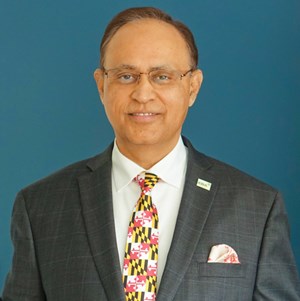January 2021 Vol. 76 No. 1
Rehab Technology
NASSCO Standard Bearer: Rizwan Siddiqi
EDITOR’S NOTE:
NASSCO continues to set standards for the assessment and rehabilitation of underground infrastructure. A vast array of individuals has contributed to the success of the association, both in the past and present, that has driven NASSCO’s industry mission. This series of articles recognizes those who have not only been critical to the success of NASSCO, but the industry as well.
This month, we profile Rizwan Siddiqi, who immigrated to the United States with his family many years ago finding a home in the underground infrastructure industry and becoming a vital part of NASSCO.
I was born in Pakistan and raised in Lahore, the capital of Punjab Province and the country’s second-largest city. With a current population of just over 12 million people, Lahore provided me with many opportunities, including an excellent education. In high school, I received a full scholarship to study engineering at the University of Engineering and Technology in Lahore, one of the top-ranking schoolsin Pakistan.
After receiving my civil engineering degree in 1981, I started work immediately with NESPAK, which stands for National Engineering Services Pakistan, a multi-national, state-owned enterprise. I was assigned to the design of the Kalabagh dam project, one of the largest hydraulic dam projects in Pakistan and, at the time, one of the largest in the world.
As part of an international consortium, NESPAK gave me the opportunity to also work with Harza Engineering, a U.S. Company in Chicago (now Stantec), and Binnie & Partners in England (now Black & Veach). As a young professional straight out of college, I was grateful to receive excellent, real-world learning in both practical experience and international business that included work on a U.S. Army Corps of Engineers Hydrologic Engineering Center’s project, HEC-6, which designates scour and deposition in rivers and reservoirs.
After I established my professional roots, I got married at the age of 26. My wife, Shahnaz, is a pediatrician by profession and worked as a Federal Government employee in Pakistan. After working a few more years in Pakistan, we decided to go to the U.S. so my wife could do her residency.
While my job responsibilities in Pakistan, as chief engineer, had grown to oversee 600 people, the move was also a good opportunity for me. I was able to study at Virginia Tech, graduating in 1996 with a master’s degree in Civil and Environmental Engineering. That same year, I received my engineer-in-training (EIT) and professional engineering (PE) licenses.
Those were very full years for me. I was working a full-time job, studying part-time for a master’s degree, raising three children, getting my EIT and P.E. credentials, and all of this while trying to navigate a new country. I spoke the English language adequately, but I did not know the slang. I remember asking a friend at Virginia Tech why people in the United States described things as “cool” when they were not cold.
No going back
At the time we moved to the U.S., our daughters were five and seven and my son was less than a year old. After two years of acclimation, my daughters announced, “We are not going back to Pakistan – you have to go back without us.” While our life in Pakistan was a
very good one, the quality of life is just not the same. We listened to our daughters and decided to stay.
The United States has been our home for the past 25 years and our children have flourished. One daughter, Sadia, is an architect, living in New York, and the mother of our nearly year-and-a-half old first grandson. Our other daughter, Sadaf, is a psychologist living in California with her husband; and our son, Moiz, completed his Ph.D. in Electrical Engineering last year and is now working for a defense contractor in Virginia.
In 1997 I began working with EBA Engineering Inc. in Maryland, where I moved up the ranks over a period of 23 years. I started as a project manager and for the past five years I have been honored to serve the organization as president and CEO. EBA has grown significantly in the last 15 years. It now has about 180 to 200 employees and five offices throughout the Mid-Atlantic region, providing a wide range of engineering services to public, quasi-public and private clients.
In 2005 I was asked to become a partner and create a water group within EBA. The demand for these services was high, as evidenced by the rapid growth of 50 additional employees in just a few years. That is when I first learned about NASSCO. I was working with Baltimore City and the Washington Suburban Sanitary Commission (WSSC), which was under a sewer consent decree that offered significant opportunity for EBA.
I am not one to delegate work that I don’t understand. For example, as a project manager I learned AutoCAD design and drafting software so that I could understand the work being done by my team. The same applied to condition assessment of water and sewer systems. I wanted to understand the inspections being performed, so in 2006 I became certified in NASSCO’s Pipeline, Manhole and Lateral Assessment and Certification Programs under the instruction of Irv Gemora. I was so impressed with PACP that I became a trainer in 2008.
NASSCO’s mission to set standards for the assessment, maintenance and rehabilitation of underground infrastructure resonated with me and I wanted to do all I could to help our industry through deeper involvement with NASSCO. EBA’s home office is located in the same region as NASSCO headquarters, so I was fortunate to teach PACP classes for NASSCO and get to know the organization and staff better.
Advocacy
I have been actively involved in several professional organizations and recently served as the president of American Council of Engineering Companies/Metropolitan Washington (ACEC/MW).
We all have different experiences and skills, and the area where I felt I could provide the most support to NASSCO was through government relations. I attended a holiday party at NASSCO headquarters in 2016, the year Donald Trump was elected. I asked Ted DeBoda, NASSCO’s executive director at the time, if he had met Trump yet.
I went on to explain that the new administration was continuously talking about infrastructure spending – but only what is above ground, not what is below. I further explained that as a national organization, it was NASSCO’s job to meet with the administration and educate it on the need to fund underground infrastructure before all of the money was spent on bridges and roads.
The next day, Ted called and asked if I would serve as chair of NASSCO’s newly formed Government Relations Committee. I didn’t have the bandwidth at the time, but I assured Ted that I would love to take an active role. The Committee was formed, a lobbyist was hired, and NASSCO’s policy recommendations were developed.
My hope for NASSCO’s future is that it continues to serve our industry though education and training, such as PACP
and ITCP (Inspector Training Certification Program), and that its influence on standards incorporates the needs of large agencies such as WSSC, DC Water and comparable agencies in other states.
Most importantly, however, my hope is that NASSCO continues its strong advocacy through its government relations efforts to encourage Congressional leaders to secure funding for critical repair of aging water and sewer pipeline infrastructure, strengthen asset management requirements and funding, and maintain regulatory compliance enforcement.
Water being my passion, I will continue to contribute my two cents in advocacy for water!
FOR MORE INFORMATION:
National Association of Sewer Service Companies, nassco.org
Rizwan Siddiqi with family at his daughter’s wedding.






Comments